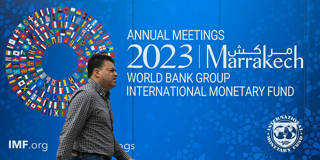Different climate-financing challenges call for different financing methods, and when it comes to building resilience in the developing world, multilateral development banks must take the lead. But to be effective, they and their shareholders must remove the shackles that have been holding them back.
LONDON – The world is confronting its biggest threat with one arm tied behind its back. Although the increasingly devastating effects of the climate crisis are becoming more apparent with each passing year, multilateral development banks (MDBs) are still playing only a marginal role in the global response. The annual meetings of the World Bank and the International Monetary Fund on October 9-15 are a crucial opportunity to change course.

LONDON – The world is confronting its biggest threat with one arm tied behind its back. Although the increasingly devastating effects of the climate crisis are becoming more apparent with each passing year, multilateral development banks (MDBs) are still playing only a marginal role in the global response. The annual meetings of the World Bank and the International Monetary Fund on October 9-15 are a crucial opportunity to change course.